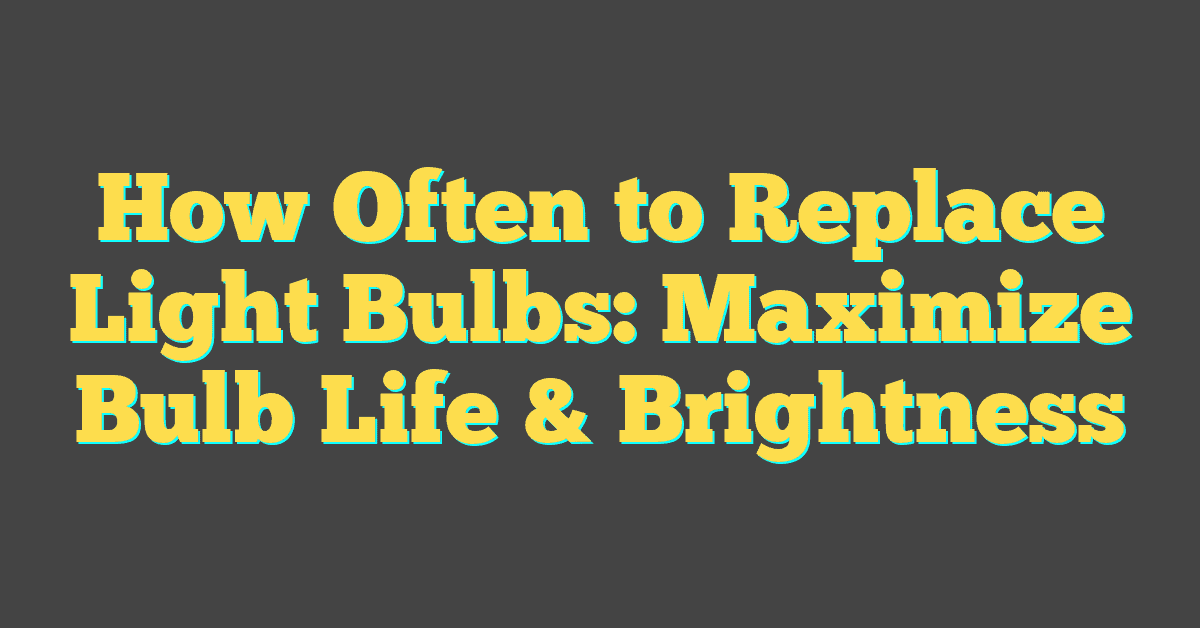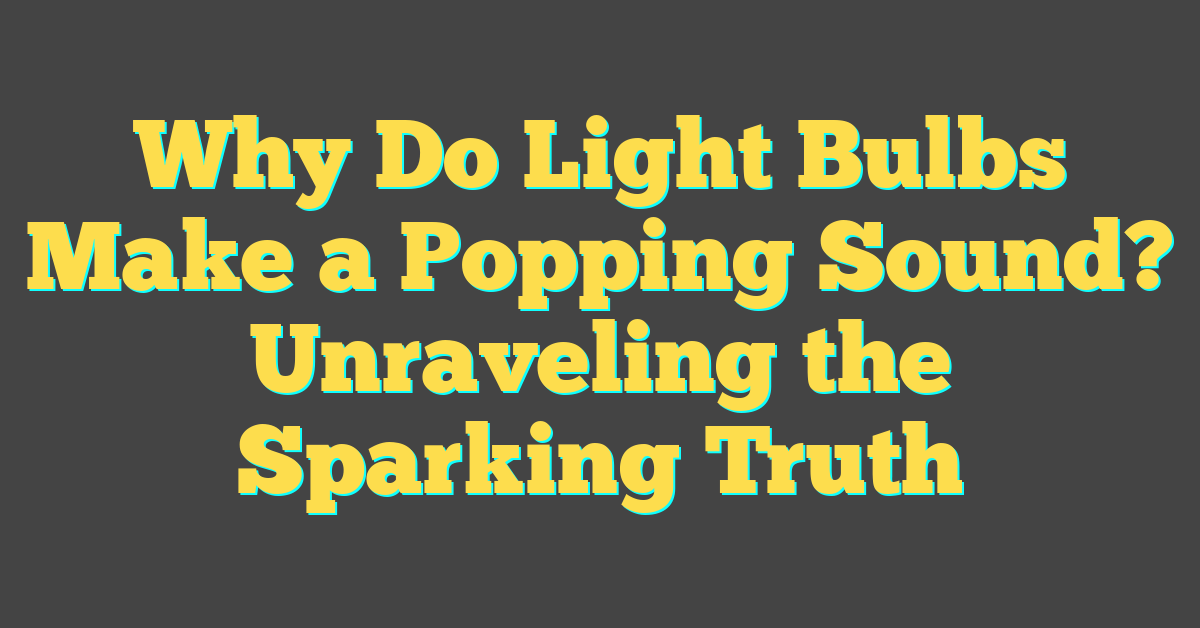Ever found yourself questioning how often you should be swapping out those lightbulbs? It’s not just you; it’s a common pondering that often leaves folks scratching their heads. After all, it’s not like they come with an expiration date, right?

Well, you’re in luck because figuring out when to replace your bulbs isn’t as mystifying as it seems. Whether it’s the flicker of a dying bulb or you’re just planning ahead, knowing the lifespan of different types of bulbs can save you from getting left in the dark.
From LEDs to fluorescents, each bulb has its own timeline and we’ve got the scoop on all of them. So, let’s shed some light on this illuminating topic and keep your home bright and welcoming.
Lifespan of Incandescent Light Bulbs
You might remember the incandescent bulbs you grew up with – they’re the classic light bulbs with a warm glow that’s been lighting up our homes for over a century. But just like any household component, they don’t last forever, and knowing when to replace them can save you from an inconvenient flicker-out.
The average lifespan of incandescent bulbs is about 750 to 2,000 hours. Now, you might wonder what this means for you in practical terms. Here’s the deal: If you’ve got a light that you use for five hours a day, a traditional incandescent bulb may last somewhere around four to five months. Not a long time, is it? Especially when compared to some of the newer tech on the block.
But the lifespan isn’t just about time. It’s affected by how often you turn the bulb on and off. Each flip of the switch wears out the filament just a little more. You’ll notice that bulbs in high-traffic areas – like your living room or kitchen – may need replacing more often than those in seldom-used spaces.
| Usage Per Day | Estimated Lifespan |
|---|---|
| 3 hours | 8-9 months |
| 5 hours | 4-5 months |
| 8 hours | 2.5-3 months |
What’s more, bulb placement can affect lifespan too. Incandescent bulbs dislike vibration. So if you’ve got one in a ceiling fan or near a door that slams often, it might have a shorter than average life.
As a DIY enthusiast and lighting aficionado, one trick is to check the bulb’s packaging for a “rated life” figure. That’s your baseline. Then, with a bit of observation and common sense, you’ll soon become adept at predicting when it’s time for a bulb swap. Keep a lookout for dimming light – it’s a telltale sign that your bulb is on its last legs.
Remember, even though incandescent bulbs have a charm to them and fit well with certain aesthetics, routine checks and knowledge of their longevity can help you maintain consistent, cozy lighting in your home without interruptions.
Lifespan of LED Light Bulbs

Transitioning to LED light bulbs offers a significant improvement in longevity compared to their incandescent counterparts. LEDs typically last between 20,000 to 50,000 hours, a substantial increase that can have a notable impact on both your wallet and the environment. Imagine installing a light bulb today and not needing to replace it for over two decades!
Here’s why LEDs have such an impressive lifespan:
- LEDs produce light differently: Instead of heating a filament like an incandescent bulb, LEDs use semiconductors to convert electricity directly into light. This process generates less heat, which is a primary factor that shortens the lifespan of traditional bulbs.
- Highly efficient: LEDs use energy more efficiently, which means less wear and tear on the components.
- Robust design: LEDs are built to withstand jarring and bumping better than fragile incandescent bulbs.
If you’re keen on home DIY projects, switching to LEDs is a no-brainer. You’ll find that there’s an LED alternative for nearly every type of incandescent bulb. Besides their durability, they also come in various colors and temperatures, giving you more control over the ambiance of your home.
Understanding the power of LEDs in terms of usage, here’s a quick reference:
| Daily Usage | Expected Lifespan |
|---|---|
| 3 hours/day | About 18 years |
| 8 hours/day | About 7 years |
| 24 hours/day | Just over 2 years |
Keep in mind, while LEDs are less sensitive to switching cycles (turning on and off), they’re not immune to it. Locations with frequent switching, like a bathroom or a closet, may slightly diminish their lifespan. Despite this, you’re still getting a massively extended lifespan.
« How Often to Change Car Light Bulbs: Stay Safe with These Tips
Why Are My Light Bulbs So Hot? Stay Cool with These 5 Fixes »
Remember to always look for the Energy Star certification when picking out LEDs. This will ensure you’re getting a bulb that meets high standards for efficiency and longevity. By embracing LED technology, you’re stepping into a world of lighting that is not only smarter and more efficient but also tailor-made for illuminating your living space with just the right touch.
Lifespan of Compact Fluorescent Light Bulbs

When you’re looking to balance cost and longevity in your lighting choices, compact fluorescent light bulbs (CFLs) strike a middle ground between traditional incandescent bulbs and the more modern LEDs. Typically, CFLs offer a lifespan of about 8,000 to 15,000 hours. This remarkable lifespan means that if you use your lights for about three hours per day, a single CFL might last from about 7 to 13 years.
CFLs operate differently from other bulbs; they contain a small amount of mercury that creates an ultraviolet light when electrified. This light then interacts with phosphor inside the bulb to produce visible light. It’s a fascinating process, one that also requires a brief warm-up period for the bulb to reach its full brightness.
Here’s a quick guide to the expected lifetime of CFLs based on average usage:
| Daily Usage (Hours) | Estimated Lifespan (Years) |
|---|---|
| 3 | 7 – 13 |
| 5 | 4 – 8 |
| 8 | 2.5 – 5 |
One reason why you’d be wise to consider CFLs for your home projects is their energy savings compared to incandescents—they use about 70% less energy and generate less heat, making them a cooler choice in more ways than one.
However, CFLs are not without their drawbacks. The presence of mercury, albeit in very small amounts, means they need to be handled carefully and recycled properly to avoid environmental harm. Their performance can also be affected by the frequent on-off cycling more so than LEDs.
Remember that to get the most out of any light bulb, positioning and proper installation are key. Pair your CFLs with the right fixtures and you’ll not only enjoy their full luminosity but also extend their operational life. So next time you’re at the store pondering over shelves of bulbs, consider the trusty CFL — a solid choice for cost-effective and efficient home lighting.
Lifespan of Halogen Light Bulbs

Switching our focus to halogen light bulbs, you’ll find they’re a step up from standard incandescents in both brightness and efficiency. Halogens are a type of incandescent bulb but with a twist: they contain a small amount of halogen gas, which allows them to burn hotter and brighter. This intense light production, while a clear perk for certain applications, does come at a cost—halogen bulbs tend to have a shorter lifespan compared to LEDs and CFLs.
On average, halogen bulbs will serve you well for about 2,000 to 4,000 hours. Now, let’s break that down: if you’re lighting up a room for about three hours a day, you’re looking at a lifespan of approximately one to two years before a replacement is due. Not bad, but still several light years behind the endurance of an LED.
Here’s a quick-view table of halogen lifespan estimates:
| Daily Use | Estimated Lifespan |
|---|---|
| 3 hours | 1-2 years |
| 6 hours | 6-11 months |
| 12 hours | 3-6 months |
Remember, these are rough estimates. Your actual mileage may vary based on the brand and how you utilize them in your DIY projects or lighting arrangements.
If you’re using halogens in high-use areas, you might notice the replacements are more frequent. This is especially true if the bulbs are exposed to vibrations, power surges, and extreme temperatures, all of which can cause premature burnout.
When you’re choosing halogen bulbs, pay attention to their rated performance. A premium quality bulb might cost a bit more upfront, but it’s likely to last longer, saving you time and hassle in the long run. Plus, it’s always better to spend a few extra bucks than to find yourself in the dark at an inopportune moment.
Next up, you’ll want to consider how halogen light output compares to other types of bulbs, as well as the ambiance they create. Sure enough, as you move through your abode, every room tells a different story with light. Let’s shed some light on how these vibrant halogens contribute to the overall feel of your living spaces.
Conclusion
You’ve got the scoop on light bulb lifespans and how halogens stack up. Remember, they’re brighter and more efficient than the old-school incandescent but don’t quite hit the longevity mark of LEDs and CFLs. Keep an eye on their performance and how they vibe with your space. When it’s time for a change, you’ll know just what to do. Happy lighting!
Frequently Asked Questions
What is the typical lifespan of an LED light bulb?
An LED light bulb typically lasts about 25,000 to 50,000 hours, significantly outperforming traditional light bulbs in longevity.
How long do compact fluorescent light bulbs (CFLs) last?
Compact fluorescent light bulbs (CFLs) have a lifespan ranging from 8,000 to 15,000 hours.
Are halogen light bulbs more efficient than standard incandescent bulbs?
Yes, halogen light bulbs are more efficient and brighter than standard incandescent bulbs.
What is the average lifespan of a halogen light bulb?
Halogen light bulbs generally last between 2,000 and 4,000 hours.
Can external factors affect the lifespan of halogen bulbs?
Yes, the lifespan of halogen bulbs can be shortened by external factors such as vibrations, power surges, and extreme temperatures.
Should I consider the light output and ambiance when choosing halogen bulbs?
Absolutely, it’s important to consider both the rated performance, as well as the light output and ambiance halogen bulbs create in different living spaces.




